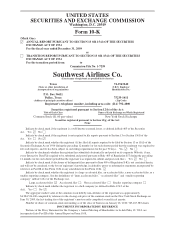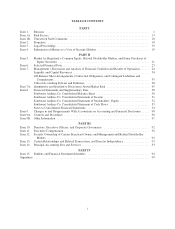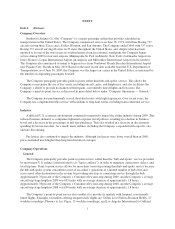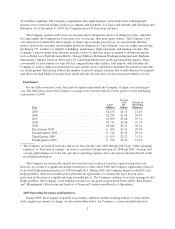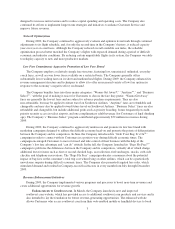Southwest Airlines 2009 Annual Report Download - page 17
Download and view the complete annual report
Please find page 17 of the 2009 Southwest Airlines annual report below. You can navigate through the pages in the report by either clicking on the pages listed below, or by using the keyword search tool below to find specific information within the annual report.Customer names exactly as they appear on a government-issued photo ID such as a passport or driver’s license.
In addition, the Company must ask Customers for their gender and date of birth. The TSA has also indicated its
intent to expand its use of whole body imaging machines around the United States.
Enhanced security measures have also impacted the Company’s business through the imposition of security
fees on the Company’s Customers and on the Company. Under the Aviation Security Act, funding for passenger
security is provided in part by a $2.50 per enplanement security fee, subject to a maximum of $5.00 per one-way
trip. The Aviation Security Act also allows the TSA to assess an Aviation Security Infrastructure Fee (“ASIF”)
on each airline. The Company’s ASIF liability was originally set at $26 million per year. Effective for calendar
year 2005, the TSA unilaterally increased the amount by an additional $24 million to a total of $50 million
annually. The Company and 22 other airlines joined in litigation against the TSA to challenge the agency’s
increase to their respective ASIF fees. In February 2009, the U.S. Court of Appeals for the District of Columbia
Circuit ruled that the increased fees were excessive and remanded the matter to the TSA to determine the amount
of the excess. The Company continues to pay the full amount of the fees pending this determination, as the TSA
rejected the airlines’ request for an interim reduction.
The Company has made significant investments to address the effect of security regulations, including
investments in facilities, equipment, and technology to process Customers efficiently and restore the airport
experience; however, the Company is not able to predict the ongoing impact, if any, that various security
measures will have on Passenger revenues and the Company’s costs, both in the short-term and the long-term.
Environmental Regulation
The Company is subject to various federal, state, and local laws and regulations relating to the protection of the
environment, including the discharge or disposal of materials such as chemicals, hazardous waste, and aircraft
deicing fluid. Additionally, in conjunction with airport authorities, other airlines, and state and local environmental
regulatory agencies, the Company, as a normal course of business, undertakes voluntary investigation or
remediation of soil or groundwater contamination at several airport sites. The Company does not believe that any
environmental liability associated with these airport sites will have a material adverse effect on the Company’s
operations, costs, or profitability, nor has it experienced any such liability in the past that has had a material adverse
effect on its operations, costs, or profitability. Further regulatory developments pertaining to such things as control
of engine exhaust emissions from ground support equipment and prevention of leaks from underground aircraft
fueling systems could increase operating costs in the airline industry. The Company does not believe, however, that
pending environmental regulatory developments in these areas will have a material effect on the Company’s capital
expenditures or otherwise materially adversely affect its operations, operating costs, or competitive position.
The federal government, as well as several state and local governments, are considering legislative and
regulatory proposals to address climate change by reducing “green house gas emissions.” At the federal level,
Congress is considering legislation that would create an economy-wide “cap-and-trade” system that would
establish a limit (or cap) on overall greenhouse gas emissions and create a market for the purchase and sale of
emissions permits or “allowances.” Under the leading cap-and-trade proposals before Congress, the airline
industry likely would be affected due to anticipated increases in fuel costs as fuel providers pass on the cost of
the emissions allowances, which they would be required to obtain, to cover the emissions from fuel production
and the eventual use of fuel by the airlines and other fuel consumers. In addition, future environmental regulatory
developments related to climate change are possible, which could significantly increase operating costs in the
airline industry and, as a result, adversely affect operations.
The Airport Noise and Capacity Act of 1990 gives airport operators the right, under certain circumstances,
to implement local noise abatement programs, so long as they do not unreasonably interfere with interstate or
foreign commerce or the national air transportation system. Some airports have established airport restrictions to
limit noise, including restrictions on aircraft types to be used, and limits on the number of hourly or daily
operations or the time of operations. These types of restrictions can cause curtailments in service or increases in
operating costs and could limit the ability of the Company to expand its operations at the affected airports.
9


